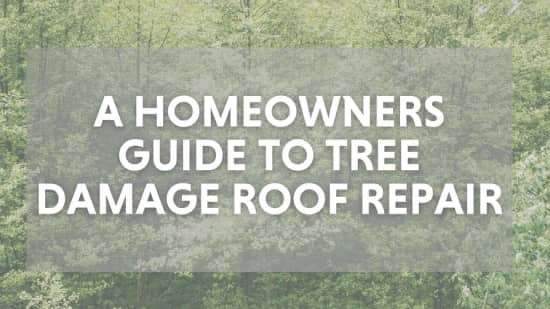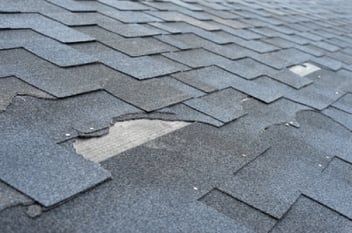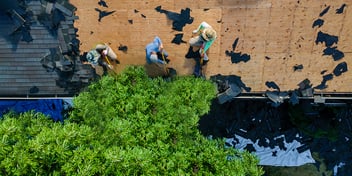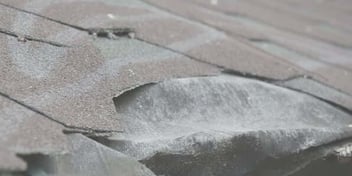- Home »
- Learningcenter »
- A homeowners guide to tree damage roof repair
A Homeowner's Guide To Tree Damage Roof Repair

When a big storm blows through your area, it's always nerve-racking to be faced with prospective damage to your home. What should you do if a tree falls on your roof? Is there any way to prevent it from happening? We help you answer those questions and more in this guide to tree damage roof repair.
What Kind Of Damage Can Trees Cause?
While the most obvious and serious damage that can be done by trees to your home is when a limb or even a whole tree falls and causes structural damage like holes and collapsed roofs - you might be surprised to learn that trees can be responsible for other kinds of damage too. The debris that gather on your roof from trees can form a pile and act like mulch, deteriorating the shingles underneath and eventually rotting the roof structure from excess moisture accumulation. Another problem that can occur from leaves and debris is when they move across your roof and clog your gutters. When your gutters become clogged, they can't function properly and water will back up onto the roof, causing rot, shingle deterioration, and leaks. Finally, smaller tree limbs that fall on your roof may not necessarily leave a hole in the structure, but they can certainly still dislodge shingles and expose the roof's underlayment. This allows rain to seep in, where it will eventually reach the home's ceilings and walls.
Can You Prevent Tree Damage?
While there isn't a way you can truly prevent tree damage from ever occurring, there are some steps you can take to make yourself a lot less likely to be facing tree damage to your roof. Make sure to keep an eye on the condition of nearby limbs, and keep the branches trimmed. This will keep branches from scraping along your roof and potentially gouging your shingles. Keep your roof clear of debris like leaves, branches, and pine needles, and make sure to clean your gutters regularly to keep your roof from falling victim to moisture and rot. Finally, and probably the most important step you can take to keep your home safe is to hire a tree expert. Having an arborist come take a look at the trees around your home (particularly if you have heavy tree coverage) and remove any unstable trees and limbs is the best way to protect yourself from what you may not even know is an unstable tree.
What Should You Do If A Tree Falls?
Even if you take all the proper precautions, unexpected extreme weather still happens, and this can leave you with a very unwelcome addition to your roof: a tree or a limb. So, what should you do if you find yourself in this situation? There's a couple important steps to take.
1. Take Pictures
Once the rain has cleared up and you can safely get a sense of the damage, it's always a good idea to take some photos. Your insurance company will usually want photos showing the extent of the damage, so it's best to take some before you remove any branches or start cleaning up. Remember to never walk on a roof that's been damaged though, as you can't tell the true extent of the damage or assess the structural integrity - it's best to put a ladder against the side of your house and get some photos from there.
2. Call Your Homeowner's Insurance
The next step to take when you find yourself with tree damage is to call your insurance company. Your insurance will likely cover all of the repairs after you meet your deductible. Homeowner's insurance usually has coverage for storm damage, so if a tree limb breaks and falls on your roof you should be okay - however, some insurance policies exclude covering trees that are rotting, diseased, or otherwise vulnerable to falling. This is another reason why it's a good idea to have an arborist come take a look at trees surrounding your home as part of regular maintenance.
3. Get The Branch Removed
While technically this is something you can do yourself to save money, the smartest route to go here is to hire a professional tree removal expert. Removing a limb from your roof is strenuous and often times involves using a heavy chainsaw, not to mention being on your roof (which could be unstable due to damage) at a potentially treacherous slope. Having it done by a professional usually should only run you about $75 - $100, and your safety is priceless.
4. Inspect The Damage
Particularly in the case of visible damage, most reputable roofing companies will provide a free assessment to let you know what kind of repairs are needed. If you have damage like major leaks, holes, or a caved in roof, look for a roofing company that does emergency repairs to get this taken care of as quickly as possible.
Even if you don't see damage that's readily apparent, tree branches can still leave you with damage that can wreak havoc on your roof over time. Make sure you check the rafters in your attic for signs of stress, and the sheathing in between. If anything is bent, cracked, or fractured from the inside, it's important to have it fixed as quickly as possible as this will lead to leaks and structural issues.
Finally, you can perform an easy test to check your roof for small leaks. Thoroughly wet your roof with a sprayer hose, and check the attic for any obvious signs of water getting in. Even a small leak can lead to big problems, like mold and wood rot, if it's not repaired in a timely manner.
5. Call A Roofer
In the case of large scale immediate repairs, your insurance company may have a list of trusted roofers in your area that will come out and fix it for you. It's important to properly vet anyone you hire for this, as emergency situations are breeding grounds for scam artists who will do the work poorly and cheaply, or just simply take your money and disappear. Most emergency roofers don’t expect full payment upfront for their services—so beware of anyone who asks for this. A roofer can help you tarp your roof, make sure there is no dangerous structural damage, and clean up any water in the interior.
At Colony Roofers, we always provide free 30 minute inspections, and have a dedicated repairs division to help with any urgent needs. If you have tree damage, leaks, or just general roofing concerns, don't hesitate to call us today!
 Call (678) 365-3138
Call (678) 365-3138


